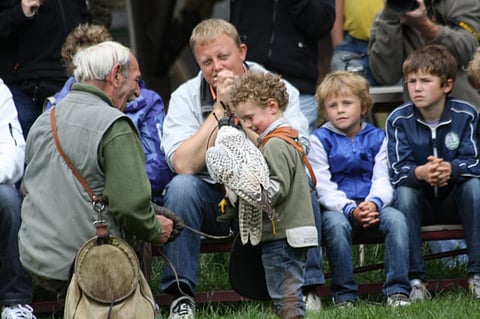The Dutch falconer
Falconry may have made its way to the Netherlands from this part of the world in ancient times but the country has die-hard practitioners determined to keep it alive

When four-year-old Samy Lenders makes friends with his first falcon — the bird comfortably perched on his gauntlet-encased arm — he is simply following a tradition. Samy’s father, Frank Lenders, runs Falconcrest, the Netherlands’ largest falconry centre and birds of prey park, along with his father, master falconer Frans Lenders.
“I started falconry with my father a long time ago and then grew into it. As more and more people go interested in it, we started it as a business,” says Frank Lenders, speaking to GN Focus on the sidelines of the Abu Dhabi International Hunting & Equestrian Exhibition (Adihex) 2012, which he has been attending for the past 15 years to showcase his falcon hunting products.
Preserving heritage
Lenders’s park, a family enterprise, is not only open for visitors who want to learn about falconry but also hosts educational excursions, company events and workshops, in addition to providing bird control services. At Adihex every year he brings his supply of falconry equipment, such as hoods and gauntlets.
The Netherlands has long been the centre of European falconry, even though it has been a means of cultural communication across kingdoms, from the French Court to Germany, Switzerland and India. In the Arab world it is said to have existed since the start of civilisations, with early mentions even in 2000BC in the Gilgamesh Epic, from where it travelled to the rest of the world.
The falconry hub
Falconry in the Netherlands reached its peak in the 19th century when it became a centre for falcon trading and trapping. At the time, many of the finest professional falconers in Europe were Dutch. In fact, Valkenswaard in southern Netherlands owes its name to falcons — valk is Dutch for falcon and falconers from the area captured wild falcons.
“In the Middle Ages only royalty was allowed to hunt with falcons, only kings and princes,” says Lenders, who maintains that regulations in the Netherlands make falconry inaccessible to many even today.
According to Falconcrest, to be eligible for the falconer diploma by Dutch law, one must spend at least two years with a mentor who is member of a recognised falconry association, and follow a theory course.
In the UAE, falconry, though encouraged as a tradition, survives in a form friendly to falcons. Under the direction of the Environmental Research and Wildlife Development Agency (ERWDA), the Shaikh Zayed Falcon Release Project is responsible for returning falcons to the wild at the end of the annual hunting season.
Distinctive methods
While in Dubai you may chance upon a falconer hired to scare away pigeons that flock around buildings, in the Netherlands too Lenders says falcons are useful to control other bird populations at airports and garbage fields.
There are differences too. In the UAE, traditional gauntlets are used, with embroidered sleeves, whereas the Dutch use thicker leather gloves. Other differences are to do with the way falcons are trained. “In Holland we have woods so we fly them differently — they go high to catch a prey. We train them on a lure. Here they use hacking [a training method that uses controlled release on a site to train young falcons in reaching their hunting potential] so they are already good for flying and hunting. In Holland we don’t have the space for hacking so we have to teach the falcon everything by ourselves. We use lures for training,” says Lenders.
Living legacy
While earlier they existed in largely insular worlds, today there is some exchange between Europe and this region on falconry. Van Gerven cites the example of a Qatari delegation’s visit to the museum of falconry in Valkenswaard.
Recognition by Unesco in 2010 of falconry as ‘living human heritage’ in countries including the UAE, Belgium, Czech Republic, France, Republic of Korea, Mongolia, Morocco, Qatar, Saudi Arabia, Spain and Syrian Arab Republic has prompted more exchange.
So much so that the state museum of the Netherlands, the Rijksmuseum, is currently holding an exhibition of 30-odd 15th-, 16th- and 17th-century prints depicting falconry. According to a press statement, “In the prints, falconers are often depicted as courtly lovers, noble saints or vain libertines. The prints will be displayed among several historical artefacts relating to falconry from the private collections of falconers.”
Sign up for the Daily Briefing
Get the latest news and updates straight to your inbox



